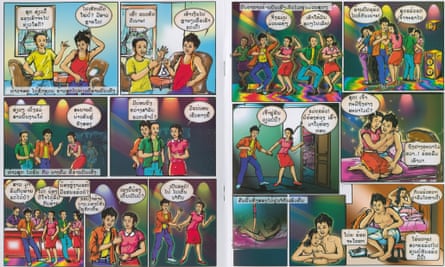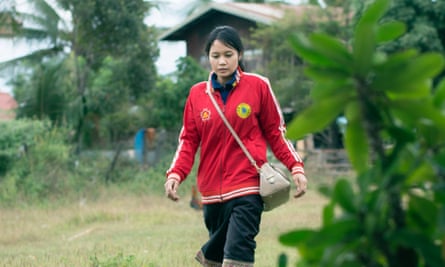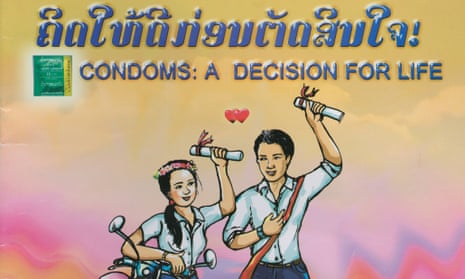Dr Arsone Vongruily stands at the entrance of the youth health clinic in Laos’s capital, Vientiane, taking an inventory of the boxes of condoms that have just arrived. “We give out almost 3,000 condoms a month at this youth centre,” she says as she counts the supply. “They’re not just for the young people who come here. They take many to give out to friends at their school too.”
The clinic is across the road from a busy secondary school and is the only place in the capital offering reproductive health services to young people, including free contraceptives and treatment of sexually transmitted infections (STIs), an outreach programme to schools, and a hotline for young people in rural areas.
The clinic is a model of what youth family planning services could look like in Laos, but health workers say too many young people remain out of reach.
Laos has one of the youngest populations in south-east Asia, with more than 60% of the population aged under 24. The country also has the highest adolescent birth rates in east Asia and the Pacific – almost one in 10 girls aged 15 to 19 has given birth. The unmet need for contraception is high, with 19% of girls aged 15 to 19 saying they want but do not have access to contraceptives.
Vongruily says attitudes discouraging young people from talking about sex have contributed to silence on the issue, preventing young people from receiving the advice they need. “It is conservative, our culture,” she says. “Some young people are shy to come to us, especially young women. That’s why it’s important to have enough female doctors, which we don’t have. Most of the girls, when they feel they need private and confidential time, need to talk to a female doctor.”
At the school opposite the clinic, Koung, 17, says she is learning about sexual health in class. “I learn about the STIs, and I know that if you don’t protect yourself by using the condom when you are having sex, you get the STIs,” she says. But the teenager says girls often receive different guidance on sex from boys. “My parents told me I have to keep my virginity until I am married because I am too young. Some families will tell the boys do not have sex before marriage like they tell the girls, but mostly it’s for the girls. In Laos women preserve themselves to keep their virginity; for boys it is easy, they can just use condoms.”

The majority of Laotians are Theravada Buddhists, and influences from traditional animist beliefs are also present, particularly among ethnic minorities. The government recognises 49 ethnic groups in Laos, with four main language groups. Many of the ethnic minorities live in mountainous regions of the country, making it harder to access a range of health services, including family planning. Of the young women aged 15 to 19 who give birth in Laos, 90% live in rural areas.
Seven hours’ drive from the capital, in the southern district of Kaysone, the head of the district hospital, Dr Sisalao Phaxaysy, says reducing high birth rates among teenage girls in the area has become a priority. He is quick to admit his hospital’s family planning services are yet to reach most of the young people who need them. “In reality, not that many young people are coming to access the service. For those who do come here, they already come with problems, but we haven’t been able to tackle the root cause. We need to work more on prevention,” he says. The district hospital offers family planning to more than 60 surrounding villages, and the majority of clients are married women. “In Lao culture, the unmarried feel shy to get counselling on contraceptives and family planning. We as health personnel do not have any judgment but they may think we do,” Phaxaysy says.
At the hospital’s family planning counselling room, 22-year-old Alisa Xaysithideth has arrived with her mother after learning about the service from an outreach worker in her village. The student says she has friends who were forced to drop out of school after becoming pregnant. “I have seen some young girls, around 14 or 15 years old, who get pregnant before marriage in school, and then they get married very quickly,” she says. “Maybe they don’t get enough knowledge about female reproductive health, or maybe they want to have children, I’m not sure.” Xaysithideth says she plans to have a baby after finishing her studies. “Maybe when I’m 26. Then I will use contraceptive after I have children. I would choose the contraception implant, I think, because it lasts a long time.”

Unsafe abortions
Abortion is illegal in Laos unless it is to save a mother’s life or preserve her physical health, and Phaxaysy says there is no data available on the number of unsafe abortions carried out in the district. “There are cases of abortions happening, but we don’t know where and by who,” he says. “We get telephone calls to our counselling rooms when girls are considering it, but if they go ahead with it we don’t hear from them. We tell the young girls, ‘don’t do anything to harm yourself’.”
It’s a similar story back in Vientiane, where Vongruily says there is little information on illegal abortions in the city. “When we meet with a girl with an unwanted pregnancy, we provide counselling and suggest she also discuss it with her family and her partner,” she says. “We explain the risks of abortions. But mainly we should tell her that abortion is illegal.”
The UN population fund (UNFPA) Laos representative, Hassan Mohtashami, says high teenage pregnancy rates and the dangers of unsafe abortions show that greater investment is required to bring family planning to those who need it. He says the UNFPA does not promote abortion as a method of family planning. “Our focus is ensuring those unwanted pregnancies don’t happen in the first place, and that young people have access to the family planning they deserve, wherever they live,” Mohtashami says.
Laos is making progress in achieving its millennium development goals, including cutting its poverty rate by 40% in the past two decades and achieving gender parity in primary schools. There have also been improvements in family planning, with the unmet need for contraception among women aged 15-49 halved in the past two decades. The UNFPA is the biggest supplier of contraceptives to Laos, while the Laotian government has committed to increasing its share.
“There have been improvements, but clearly we have more work to do,” Mohtashami says. “I’ve always said that the best indicator of how committed a government is to its women is how many contraceptives they buy. From then, we work on getting them to everyone who needs them – that’s our challenge.”

Comments (…)
Sign in or create your Guardian account to join the discussion